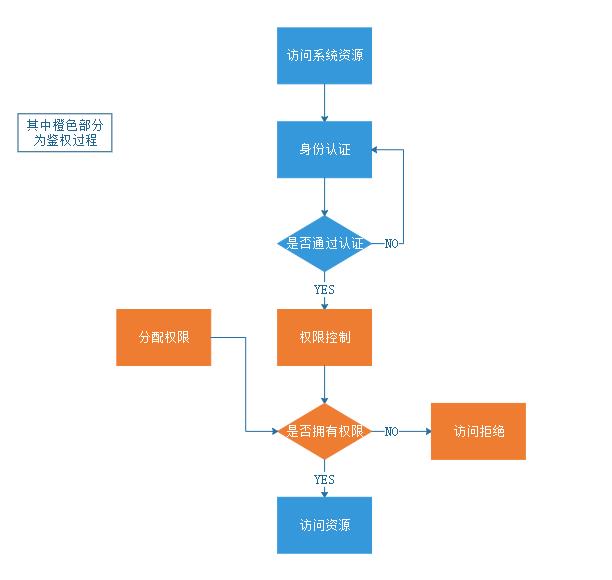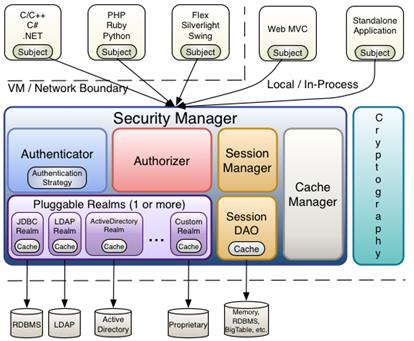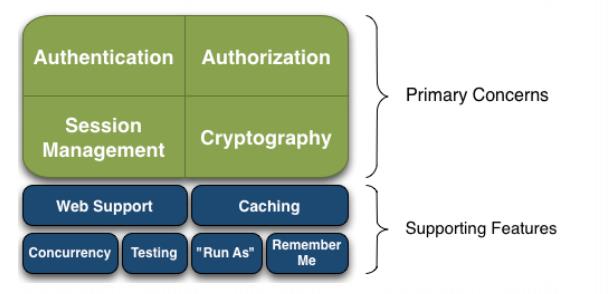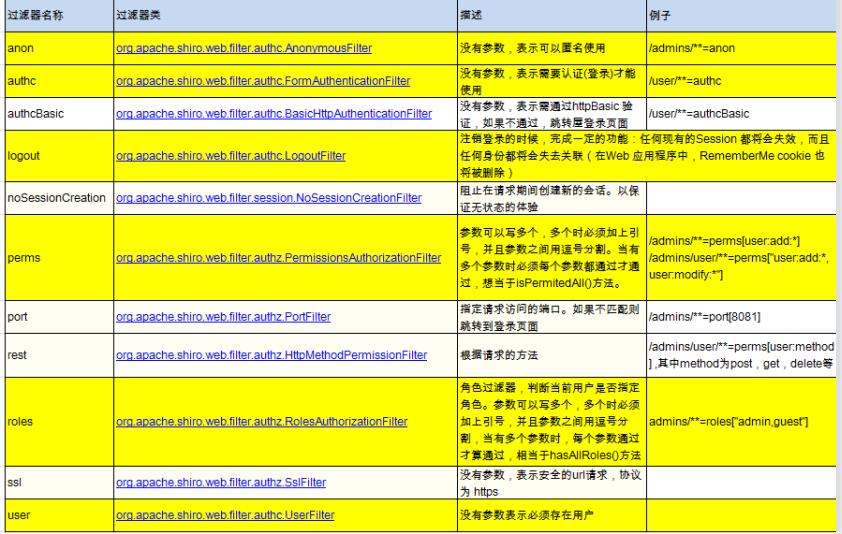shiro权限框架
Posted 编程小栈
tags:
篇首语:本文由小常识网(cha138.com)小编为大家整理,主要介绍了shiro权限框架相关的知识,希望对你有一定的参考价值。
文章目录
Shiro架构与功能介绍
1.认证与授权相关基本概念
两个基本的概念
安全实体:系统需要保护的具体对象数据
权限:系统相关的功能操作,例如基本的CRUD
Authentication:身份认证/登录,验证用户是不是拥有相应的身份;
Authorization:授权,即权限验证,验证某个已认证的用户是否拥有某个权限;即判断用户是否能做事情,常见的如:验证某个用户是否拥有某个角色。或者细粒度的验证某个用户对某个资源是否具有某个权限;
Session Manager:会话管理,即用户登录后就是一次会话,在没有退出之前,它的所有信息都在会话中;会话可以是普通JavaSE环境的,也可以是如Web环境的;
Cryptography:加密,保护数据的安全性,如密码加密存储到数据库,而不是明文存储;
Web Support:Web支持,可以非常容易的集成到Web环境;
Caching:缓存,比如用户登录后,其用户信息、拥有的角色/权限不必每次去查,这样可以提高效率;
Concurrency:shiro支持多线程应用的并发验证,即如在一个线程中开启另一个线程,能把权限自动传播过去;
Testing:提供测试支持;
Run As:允许一个用户假装为另一个用户(如果他们允许)的身份进行访问;
Remember Me:记住我,这个是非常常见的功能,即一次登录后,下次再来的话不用登录了。
2.Shiro四大核心功能
Authentication,Authorization,Cryptography,Session Management
3.Shiro三个核心组件
Subject:主体,代表了当前“用户”,这个用户不一定是一个具体的人,与当前应用交互的任何东西都是Subject,如网络爬虫,机器人等;即一个抽象概念;所有Subject都绑定到SecurityManager,与Subject的所有交互都会委托给SecurityManager;可以把Subject认为是一个门面;SecurityManager才是实际的执行者;
SecurityManager:安全管理器;即所有与安全有关的操作都会与SecurityManager交互;且它管理着所有Subject;可以看出它是Shiro的核心,它负责与后边介绍的其他组件进行交互,如果学习过SpringMVC,你可以把它看成DispatcherServlet前端控制器;
Realm:域,Shiro从从Realm获取安全数据(如用户、角色、权限),就是说SecurityManager要验证用户身份,那么它需要从Realm获取相应的用户进行比较以确定用户身份是否合法;也需要从Realm得到用户相应的角色/权限进行验证用户是否能进行操作;可以把Realm看成DataSource,即安全数据源。
spring security和shiro的区别
相同点:
1.其核心都是一组过滤器链
2.认证功能
3.授权功能
4.加密功能
5.会话管理
6.缓存支持
7.rememberMe功能
不同点:
1.Spring Security是一个重量级的安全管理框架;Shiro则是一个轻量级的安全管理框架
2.Spring Security 基于Spring开发,项目若使用Spring作为基础,配合Spring Security 做权限更便捷,而Shiro需要和Spring 进行整合开发;
3.Spring Security 功能比Shiro更加丰富些,例如安全维护方面;
4.Spring Security 社区资源相对于Shiro更加丰富;
5.Shiro 的配置和使用比较简单,Spring Security 上手复杂些;
6.Shiro 依赖性低,不需要任何框架和容器,可以独立运行, Spring Security依赖Spring容器;
7.Shiro 不仅仅可以使用在web中,它可以工作在任何应用环境中。在集群会话时Shiro最重要的一个好处或许就是它的会话是独立于容器的;
第一章 权限概述
1、什么是权限
权限管理,一般指根据系统设置的安全策略或者安全规则,用户可以访问而且只能访问自己被授权的资源,不多不少。权限管理几乎出现在任何系统里面,只要有用户和密码的系统。
权限管理在系统中一般分为:
-
访问权限
一般表示你能做什么样的操作,或者能够访问那些资源。例如:给张三赋予“店铺主管”角色,“店铺主管”具有“查询员工”、“添加员工”、“修改员工”和“删除员工”权限。此时张三能够进入系统,则可以进行这些操作 -
数据权限
一般表示某些数据你是否属于你,或者属于你可以操作范围。例如:张三是"店铺主管"角色,他可以看他手下客服人员所有的服务的买家订单信息,他的手下只能看自己负责的订单信息
2、认证概念
【1】什么是认证
身份认证,就是判断一个用户是否为合法用户的处理过程。最常用的简单身份认证方式是系统通过核对用户输入的用户名和密码,看其是否与系统中存储的该用户的用户名和密码一致,来判断用户身份是否正确。例如:密码登录,手机短信验证、三方授权等
【2】认证流程

【3】关键对象
上边的流程图中需要理解以下关键对象:
Subject:主体:访问系统的用户,主体可以是用户、程序等,进行认证的都称为主体;
Principal:身份信息是主体(subject)进行身份认证的标识,标识必须具有唯一性,如用户名、手机号、邮箱地址等,一个主体可以有多个身份,但是必须有一个主身份(Primary Principal)。
credential:凭证信息:是只有主体自己知道的安全信息,如密码、证书等。
3、授权概念
【1】什么是授权
授权,即访问控制,控制谁能访问哪些资源。主体进行身份认证后,系统会为其分配对应的权限,当访问资
源时,会校验其是否有访问此资源的权限。
这里首先理解4个对象。
用户对象user:当前操作的用户、程序。
资源对象resource:当前被访问的对象
角色对象role :一组 “权限操作许可权” 的集合。
权限对象permission:权限操作许可权
【2】授权流程

【3】关键对象
授权可简单理解为who对what进行How操作
**Who:**主体(Subject),可以是一个用户、也可以是一个程序
**What:**资源(Resource),如系统菜单、页面、按钮、方法、系统商品信息等。
访问类型:商品菜单,订单菜单、分销商菜单
数据类型:我的商品,我的订单,我的评价
**How:**权限/许可(Permission)
我的商品(资源)===>访问我的商品(权限许可)
分销商菜单(资源)===》访问分销商列表(权限许可)
第二章 Shiro概述
1、Shiro简介
【1】什么是Shiro?
Shiro是apache旗下一个开源框架,它将软件系统的安全认证相关的功能抽取出来,实现用户身份认证,权限授权、加密、会话管理等功能,组成了一个通用的安全认证框架。
【2】Shiro 的特点
Shiro 是一个强大而灵活的开源安全框架,能够非常清晰的处理认证、授权、管理会话以及密码加密。如下是它所具有的特点:
· 易于理解的 Java Security API;
· 简单的身份认证(登录),支持多种数据源(LDAP,JDBC 等);
· 对角色的简单的签权(访问控制),也支持细粒度的鉴权;
· 支持一级缓存,以提升应用程序的性能;
· 内置的基于 POJO 企业会话管理,适用于 Web 以及非 Web 的环境;
· 异构客户端会话访问;
· 非常简单的加密 API;
· 不跟任何的框架或者容器捆绑,可以独立运行。
2、核心组件
- Shiro架构图

- Subject
Subject主体,外部应用与subject进行交互,subject将用户作为当前操作的主体,这个主体:可以是一个通过浏览器请求的用户,也可能是一个运行的程序。Subject在shiro中是一个接口,接口中定义了很多认证授相关的方法,外部程序通过subject进行认证授,而subject是通过SecurityManager安全管理器进行认证授权
- SecurityManager
SecurityManager权限管理器,它是shiro的核心,负责对所有的subject进行安全管理。通过SecurityManager可以完成subject的认证、授权等,SecurityManager是通过Authenticator进行认证,通过Authorizer进行授权,通过SessionManager进行会话管理等。SecurityManager是一个接口,继承了Authenticator, Authorizer, SessionManager这三个接口
- Authenticator
Authenticator即认证器,对用户登录时进行身份认证
- Authorizer
Authorizer授权器,用户通过认证器认证通过,在访问功能时需要通过授权器判断用户是否有此功能的操作权限。
- Realm(数据库读取+认证功能+授权功能实现)
Realm领域,相当于datasource数据源,securityManager进行安全认证需要通过Realm获取用户权限数据
比如:
如果用户身份数据在数据库那么realm就需要从数据库获取用户身份信息。
注意:
不要把realm理解成只是从数据源取数据,在realm中还有认证授权校验的相关的代码。
- SessionManager
SessionManager会话管理,shiro框架定义了一套会话管理,它不依赖web容器的session,所以shiro可以使用在非web应用上,也可以将分布式应用的会话集中在一点管理,此特性可使它实现单点登录。
- SessionDAO
SessionDAO即会话dao,是对session会话操作的一套接口
比如:
可以通过jdbc将会话存储到数据库
也可以把session存储到缓存服务器
- CacheManager
CacheManager缓存管理,将用户权限数据存储在缓存,这样可以提高性能
- Cryptography
Cryptography密码管理,shiro提供了一套加密/解密的组件,方便开发。比如提供常用的散列、加/解密等功能
第三章 Shiro入门
1.1什么是shiro
-
Apache Shiro 是 Java 的一个安全(权限)框架。
-
Shiro 可以非常容易的开发出足够好的应用,其不仅可以用在JavaSE 环境,也可以用在 JavaEE 环境。
-
Shiro 可以完成:认证、授权、加密、会话管理、与Web 集成、缓存等。
下载:http://shiro.apache.org/
1.2shiro功能简介

**Authentication:**身份认证/登录,验证用户是不是拥有相应的身份;
**Authorization:**授权,即权限验证,验证某个已认证的用户是否拥有某个权限;即判断用户是否能进行什么操作,如:验证某个用户是否拥有某个角色。或者细粒度的验证某个用户对某个资源是否具有某个权限;
Session Manager:会话管理**,即用户登录后就是一次会话,在没有退出之前,它的所有信息都在会话中;**会话可以是普通 JavaSE环境,也可以是 Web 环境;
Cryptography:加密,保护数据的安全性,如密码加密存储到数据库,而不是明文存储;
Web Support:Web 支持,可以非常容易的集成到Web 环境;
Caching:缓存,比如用户登录后,其用户信息、拥有的角色/权限不必每次去查,这样可以提高效率;
Concurrency:Shiro 支持多线程应用的并发验证,即如在一个线程中开启另一个线程,能把权限自动传播过去;
Testing:提供测试支持;
Run As:允许一个用户假装为另一个用户(如果他们允许)的身份进行访问;
Remember Me:记住我,这个是非常常见的功能,即一次登录后,下次再来的话不用登录了
2.1外部来看Shiro
即从应用程序角度的来观察如何使用 Shiro 完成工作:

**Subject:**应用代码直接交互的对象是 Subject,也就是说 Shiro 的对外API 核心就是 Subject。Subject 代表了当前“用户”, 这个用户不一定是一个具体的人,与当前应用交互的任何东西都是 Subject,如网络爬虫,机器人等;与 Subject 的所有交互都会委托给 SecurityManager;Subject 其实是一个门面,SecurityManager 才是实际的执行者。
SecurityManager:安全管理器;即所有与安全有关的操作都会与SecurityManager 交互;且其管理着所有 Subject;可以看出它是Shiro的核心**,它负责与 Shiro 的其他组件进行交互,它相当于 SpringMVC 中DispatcherServlet 的角色。
**Realm:**Shiro 从 Realm 获取安全数据(如用户、角色、权限),就是说SecurityManager 要验证用户身份,那么它需要从 Realm 获取相应的用户进行比较以确定用户身份是否合法;也需要从 Realm 得到用户相应的角色/权限进行验证用户是否能进行操作;可以把 Realm 看成 DataSource
2.2内部来看Shiro

**Subject:**任何可以与应用交互的“用户”。
**SecurityManager :**相当于SpringMVC 中的 DispatcherServlet;是 Shiro 的心脏;所有具体的交互都通过 SecurityManager 进行控制;它管理着所有 Subject、且负责进行认证、授权、会话及缓存的管理。
Authenticator:负责 Subject 认证**,是一个扩展点,可以自定义实现;可以使用认证策略(Authentication Strategy),即什么情况下算用户认证通过了。
Authorizer:授权器、即访问控制器,用来决定主体是否有权限进行相应的操作;即控制着用户能访问应用中的哪些功能。
**Realm:**可以有 1 个或多个 Realm,可以认为是安全实体数据源,即用于获取安全实体的;可以是JDBC 实现,也可以是内存实现等等;由用户提供;所以一般在应用中都需要实现自己的 Realm。
SessionManager:管理 Session 生命周期的组件;而 Shiro 并不仅仅可以用在 Web 环境,也可以用在如普通的 JavaSE 环境 。
CacheManager:缓存控制器,来管理如用户、角色、权限等的缓存的;因为这些数据基本上很少改变,放到缓存中后可以提高访问的性能。
Cryptography:密码模块,Shiro 提高了一些常见的加密组件用于如密码加密/解密。
2.3javase入门案例
导入jar包
– shiro-all-1.3.2.jar
– log4j-1.2.15.jar
– slf4j-api-1.6.1.jar
– slf4j-log4j12-1.6.1.jar
Quickstart类:演示 session 存储、用户登录,登出,角色、行为。
package com.cfl;
import org.apache.shiro.SecurityUtils;
import org.apache.shiro.authc.*;
import org.apache.shiro.config.IniSecurityManagerFactory;
import org.apache.shiro.mgt.SecurityManager;
import org.apache.shiro.session.Session;
import org.apache.shiro.subject.Subject;
import org.apache.shiro.util.Factory;
import org.slf4j.Logger;
import org.slf4j.LoggerFactory;
/**
* Simple Quickstart application showing how to use Shiro's API.
*
* @since 0.9 RC2
*/
public class Quickstart
private static final transient Logger log = LoggerFactory.getLogger(Quickstart.class);
public static void main(String[] args)
// The easiest way to create a Shiro SecurityManager with configured
// realms, users, roles and permissions is to use the simple INI config.
// We'll do that by using a factory that can ingest a .ini file and
// return a SecurityManager instance:
// Use the shiro.ini file at the root of the classpath
// (file: and url: prefixes load from files and urls respectively):
Factory<SecurityManager> factory = new IniSecurityManagerFactory("classpath:shiro.ini");
SecurityManager securityManager = factory.getInstance();
// for this simple example quickstart, make the SecurityManager
// accessible as a JVM singleton. Most applications wouldn't do this
// and instead rely on their container configuration or web.xml for
// webapps. That is outside the scope of this simple quickstart, so
// we'll just do the bare minimum so you can continue to get a feel
// for things.
SecurityUtils.setSecurityManager(securityManager);
// Now that a simple Shiro environment is set up, let's see what you can do:
// get the currently executing user:
// 获取当前的 Subject. 调用 SecurityUtils.getSubject();
Subject currentUser = SecurityUtils.getSubject();
// Do some stuff with a Session (no need for a web or EJB container!!!)
/**
* 一、测试使用 Session
* 获取 Session: Subject#getSession()
*/
Session session = currentUser.getSession();
session.setAttribute("someKey", "aValue");
String value = (String) session.getAttribute("someKey");
if (value.equals("aValue"))
log.info("---> Retrieved the correct value! [" + value + "]");
// let's login the current user so we can check against roles and permissions:
/**
* 二、测试当前的用户是否已经被认证. 即是否已经登录.
* 调动 Subject 的 isAuthenticated()
*/
if (!currentUser.isAuthenticated())
// 把用户名和密码封装为 UsernamePasswordToken 对象
UsernamePasswordToken token = new UsernamePasswordToken("lonestarr", "vespa");
// rememberme
token.setRememberMe(true);
try
// 执行登录.
currentUser.login(token);
// 1. 若没有指定的账户, 则 shiro 将会抛出 UnknownAccountException 异常.
catch (UnknownAccountException uae)
log.info("----> There is no user with username of " + token.getPrincipal());
return;
// 2. 若账户存在, 但密码不匹配, 则 shiro 会抛出 IncorrectCredentialsException 异常。
catch (IncorrectCredentialsException ice)
log.info("----> Password for account " + token.getPrincipal() + " was incorrect!");
return;
// 3. 用户被锁定的异常 LockedAccountException
catch (LockedAccountException lae)
log.info("The account for username " + token.getPrincipal() + " is locked. " +
"Please contact your administrator to unlock it.");
// ... catch more exceptions here (maybe custom ones specific to your application?
// 所有认证时异常的父类.
catch (AuthenticationException ae)
//unexpected condition? error?
//say who they are:
//print their identifying principal (in this case, a username):
log.info("----> User [" + currentUser.getPrincipal() + "] logged in successfully.");
//test a role:
/**
* 三、测试是否有某一个角色.
* 调用 Subject 的 hasRole 方法.
*/
if (currentUser.hasRole("schwartz"))
log.info("----> May the Schwartz be with you!");
else
log.info("----> Hello, mere mortal.");
return;
//test a typed permission (not instance-level)
/**
* 四、测试用户是否具备某一个行为.
* 调用 Subject 的 isPermitted() 方法。
*/
if (currentUser.isPermitted("lightsaber:weild"))
log.info("----> You may use a lightsaber ring. Use it wisely.");
else
log.info("Sorry, lightsaber rings are for schwartz masters only.");
//a (very powerful) Instance Level permission:
// 测试用户是否具备某一个行为.
if (currentUser.isPermitted("user:delete:zhangsan"))
log.info("----> You are permitted to 'drive' the winnebago with license plate (id) 'eagle5'. " +
"Here are the keys - have fun!");
else
log.info("Sorry, you aren't allowed to drive the 'eagle5' winnebago!");
//all done - log out!
/**
* 五、执行登出
* 调用 Subject 的 Logout() 方法.
*/
System.out.println("---->" + currentUser.isAuthenticated());
currentUser.logout();
System.out.println("---->" + currentUser.isAuthenticated());
System.exit(0);
shiro.ini
#
# Licensed to the Apache Software Foundation (ASF) under one
# or more contributor license agreements. See the NOTICE file
# distributed with this work for additional information
# regarding copyright ownership. The ASF licenses this file
# to you under the Apache License, Version 2.0 (the
# "License"); you may not use this file except in compliance
# with the License. You may obtain a copy of the License at
#
# http://www.apache.org/licenses/LICENSE-2.0
#
# Unless required by applicable law or agreed to in writing,
# software distributed under the License is distributed on an
# "AS IS" BASIS, WITHOUT WARRANTIES OR CONDITIONS OF ANY
# KIND, either express or implied. See the License for the
# specific language governing permissions and limitations
# under the License.
#
# =============================================================================
# Quickstart INI Realm configuration
#
# For those that might not understand the references in this file, the
# definitions are all based on the classic Mel Brooks' film "Spaceballs". ;)
# =============================================================================
# -----------------------------------------------------------------------------
# Users and their assigned roles
#
# Each line conforms to the format defined in the
# org.apache.shiro.realm.text.TextConfigurationRealm#setUserDefinitions JavaDoc
# -----------------------------------------------------------------------------
[users]
# user 'root' with password 'secret' and the 'admin' role
root = secret, admin
# user 'guest' with the password 'guest' and the 'guest' role
guest = guest, guest
# user 'presidentskroob' with password '12345' ("That's the same combination on
# my luggage!!!" ;)), and role 'president'
presidentskroob = 12345, president
# user 'darkhelmet' with password 'ludicrousspeed' and roles 'darklord' and 'schwartz'
darkhelmet = ludicrousspeed, darklord, schwartz
# user 'lonestarr' with password 'vespa' and roles 'goodguy' and 'schwartz'
lonestarr = vespa, goodguy, schwartz
# -----------------------------------------------------------------------------
# Roles with assigned permissions
#
# Each line conforms to the format defined in the
# org.apache.shiro.realm.text.TextConfigurationRealm#setRoleDefinitions JavaDoc
# -----------------------------------------------------------------------------
[roles]
# 'admin' role has all permissions, indicated by the wildcard '*'
admin = *
# The 'schwartz' role can do anything (*) with any lightsaber:
schwartz = lightsaber:*
# The 'goodguy' role is allowed to 'delete' (action) the user (type) with
# license plate 'zhangsan' (instance specific id)
goodguy = user:delete:zhangsan
2.4shiro中默认的过滤器

2.5URL匹配模式与匹配顺序
url 模式使用 Ant 风格模式
• Ant 路径通配符支持 ?、*、 **,注意通配符匹配不包括目录分隔符“/”:
– ?:匹配一个字符,如 /admin? 将匹配 /admin1,但不匹配 /admin 或 /admin/;
– *:匹配零个或多个字符串,如 /admin 将匹配 /admin、/admin123,但不匹配 /admin/1;
– *:匹配路径中的零个或多个路径,如 /admin/* 将匹配 /admin/a 或 /admin/a/b
URL 权限采取第一次匹配优先的方式
即从头开始使用第一个匹配的 url 模式对应的拦截器链。
• 如:
– /bb/**=filter1
– /bb/aa=filter2
– /**=filter3
– 如果请求的url是“/bb/aa”,因为按照声明顺序进行匹配,那么将使用 filter1 进行拦截。
2.6shiro与web集成
主要代码略。。。
关于过滤器:
<!--
1. 配置 Shiro 的 shiroFilter.
2. DelegatingFilterProxy 实际上是 Filter 的一个代理对象. 默认情况下, Spring 会到 IOC 容器中查找和
<filter-name> 对应的 filter bean. 也可以通过 targetBeanName 的初始化参数来配置 filter bean 的 id.
-->
<filter>
<filter-name>shiroFilter</filter-name>
<filter-class>org.springframework.web.filter.DelegatingFilterProxy</filter-class>
<init-param>
<param-name>targetFilterLifecycle</param-name>
<param-value>true</param-value>
</init-param>
</filter>
<filter-mapping>
<filter-name>shiroFilter</filter-name>
<url-pattern>/*</url-pattern>
</filter-mapping>
org.springframework.web.filter.DelegatingFilterProxy
protected Filter initDelegate(WebApplicationContext wac) throws ServletException
Filter delegate = wac.getBean(getTargetBeanName(), Filter.class);
if (isTargetFilterLifecycle())
delegate.init(getFilterConfig());
return delegate;
认证流程
1、首先调用 Subject.login(token) 进行登录,其会自动委托给SecurityManager
2、SecurityManager 负责真正的身份验证逻辑;它会委托给Authenticator 进行身份验证;
3、Authenticator 才是真正的身份验证者,Shiro API 中核心的身份认证入口点,此处可以自定义插入自己的实现;
4、Authenticator 可能会委托给相应的 AuthenticationStrategy 进 行多 Realm 身份验证,默认 ModularRealmAuthenticator 会调用AuthenticationStrategy 进行多 Realm 身份验证;
5、Authenticator 会把相应的 token 传入 Realm,从 Realm 获取身份验证信息,如果没有返回/抛出异常表示身份验证失败了。此处可以配置多个Realm,将按照相应的顺序及策略进行访问。

// 获取主体
Subject currentUser = SecurityUtils.getSubject();
// 生产token验证登录
UsernamePasswordToken token = new UsernamePasswordToken(username, password);
currentUser.login(token);
org.apache.shiro.subject.support.DelegatingSubject#login
Subject subject = this.securityManager.login(this, token);
org.apache.shiro.mgt.AuthenticatingSecurityManager#authenticate
return this.authenticator.authenticate(token);
org.apache.shiro.authc.AbstractAuthenticator#authenticate
AuthenticationInfo info = this.doAuthenticate(token);
org.apache.shiro.authc.pam.ModularRealmAuthenticator#doAuthenticate
protected AuthenticationInfo doAuthenticate(AuthenticationToken authenticationToken) throws AuthenticationException
this.assertRealmsConfigured();
Collection<Realm> realms = this.getRealms();
return realms.size() == 1 ? this.doSingleRealmAuthentication((Realm)realms.iterator().next(), authenticationToken) : this.doMultiRealmAuthentication(realms, authenticationToken);
org.apache.shiro.authc.pam.ModularRealmAuthenticator#doSingleRealmAuthentication
org.apache.shiro.realm.AuthenticatingRealm#getAuthenticationInfo
// 完成密码比对
org.apache.shiro.realm.AuthenticatingRealm#assertCredentialsMatch
CredentialsMatcher cm = this以上是关于shiro权限框架的主要内容,如果未能解决你的问题,请参考以下文章